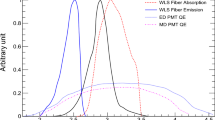Abstract
The most important condition for starting work at the NICA accelerator complex, which is a powerful source of ionizing radiation, is to obtain a sanitary-epidemiological conclusion with the justification of a sanitary-protection zone around the facility. The size and configuration of the sanitary-protective zone around the NICA complex are determined by the mode of operation and the loss of particles in its various elements. Based on the calculations of the radiation situation performed earlier, the boundaries of the sanitary-protective zones have been defined for the heavy ions collision mode of the collider operation and for the additional mode in which high-energy protons interact in the collider.


Similar content being viewed by others
REFERENCES
Technical Project of the Complex NICA, Sect.: Technical Specification (Passport) of the NICA Complex (JINR, Dubna, 2018).
G. N. Timoshenko and I. S. Gordeev, “Forecasting radiation environment around the NICA booster,” Phys. Part. Nucl. Lett. 17, 379–388 (2020).
M. Paraipan and G. N. Timoshenko, “Radiation protection of the NICA collider,” Herald Int. Univ. Nat., Soc. Man Dubna, No. 2 (30), 87–92 (2014).
M. Paraipan and G. N. Timoshenko, “Estimating the main radiation source terms for the NICA collider,” Phys. Part. Nucl. Lett. 9, 643–647 (2012).
G. N. Timoshenko and M. Paraipan, “Formation of secondary radiation fields at NICA,” Nucl. Instrum. Methods Phys. Res., Sect. B 267, 2866–2869 (2009).
L. Beskrovnaia, L. Latysheva, M. Paraipan, N. Sobolevsky, and G. Timoshenko, “Simulation of residual activity in steel and copper targets induced by 950 MeV/n uranium ions,” Phys. Part. Nucl. Lett. 8, 364–367 (2011).
L. Beskrovnaia, B. Florko, M. Paraipan, N. Sobolevsky, and G. Timoshenko, “Verification of Monte Carlo transport codes FLUKA, GEANT4 and SHIELD for radiation protection purposes at relativistic heavy-ion accelerators,” Nucl. Instrum. Methods Phys. Res., Sect. B 266, 4058–4060 (2008).
A. Krylov, M. Paraipan, N. Sobolevsky, G. Timoshenko, and V. Tret’yakov, “GEANT4, MCNPX, and SHIELD code comparison concerning relativistic heavy ion interaction with matter,” Phys. Part. Nucl. Lett. 11, 549–551 (2014).
ICRP, “Conversion coefficients for radiological protection quantities for external radiation exposures,” ICRP Publ. No. 116, Ann. ICRP 40 (2-5) (2010).
Main Sanitary Rules of Radiation Protection Guarantee for Workers and the Public OSPORB-99/2010 (Russ. Ministry of Health, Moscow, 2010).
Author information
Authors and Affiliations
Corresponding author
Ethics declarations
The authors declare that they have no conflicts of interest.
Rights and permissions
About this article
Cite this article
Butenko, A.V., Gordeev, I.S., Kovalenko, A.D. et al. Prediction of Radiation Environment around NICA Complex. Phys. Part. Nuclei Lett. 19, 123–128 (2022). https://doi.org/10.1134/S1547477122020042
Received:
Revised:
Accepted:
Published:
Issue Date:
DOI: https://doi.org/10.1134/S1547477122020042




